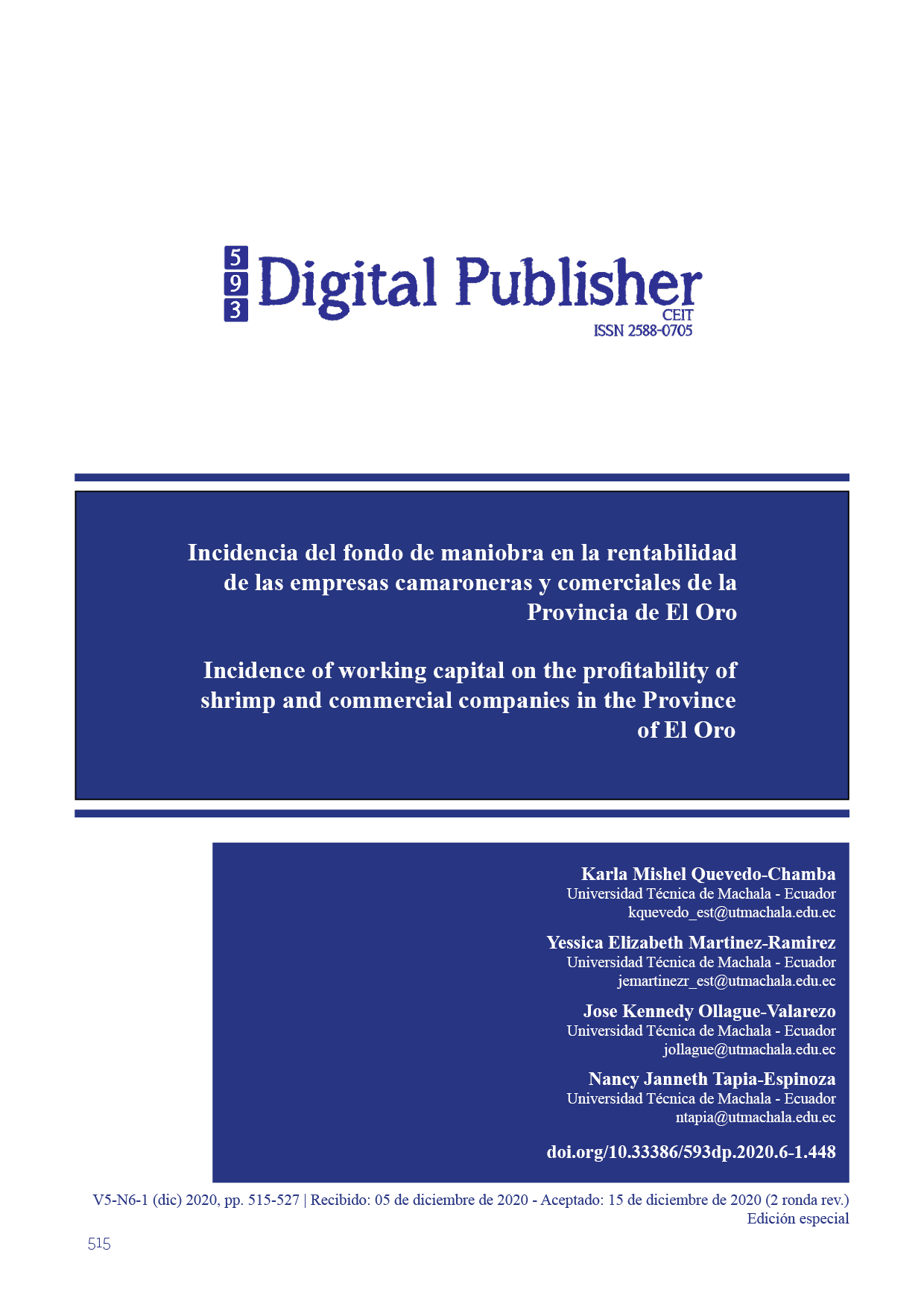Incidence of working capital on the profitability of shrimp and commercial companies in the Province of El Oro
Main Article Content
Abstract
In this research an analysis is carried out on the importance of the administration of the working capital in companies, the shrimp and commercial sector of the Province of El Oro, to determine if it has an impact on their profitability. The working capital is the minimum cash that every organization needs to continue with its operations in a normal way without interruptions, since an efficient management of it allows the company to have the necessary liquidity that in turn allows to cover short-term obligations with third parties, taking into account the cash conversion cycle, that is, the time it takes the company to convert its assets into cash and also considering the current ratio and the return on investment that also helps to make the payment of the obligations that the company has For this, the descriptive methodology was applied, in which research sources such as scientific articles and books are used, the quantitative methodology that allows determining the sample size was also applied and some of the financial indicators were used, such as current ratio, ROA and ROE to make a comparison of the companies and the management that each one has on the working capital bra. As a result, it was determined that working capital is a tool that every manager must bear in mind because it is the basis for the survival of companies without the need to resort to financing in order to increase their profitability. The calculation of other indicators that help to evaluate the progress of companies should also be incorporated.
Downloads
Article Details

This work is licensed under a Creative Commons Attribution-NonCommercial-ShareAlike 4.0 International License.
1. Derechos de autor
Las obras que se publican en 593 Digital Publisher CEIT están sujetas a los siguientes términos:
1.1. 593 Digital Publisher CEIT, conserva los derechos patrimoniales (copyright) de las obras publicadas, favorece y permite la reutilización de las mismas bajo la licencia Licencia Creative Commons 4.0 de Reconocimiento-NoComercial-CompartirIgual 4.0, por lo cual se pueden copiar, usar, difundir, transmitir y exponer públicamente, siempre que:
1.1.a. Se cite la autoría y fuente original de su publicación (revista, editorial, URL).
1.1.b. No se usen para fines comerciales u onerosos.
1.1.c. Se mencione la existencia y especificaciones de esta licencia de uso.
References
Altamirano et al., A. (2017). Importancia de la administración eficiente del capital de trabajo en las Pymes. Revista Ciencia UNEMI, 32-33.
Altuve, G. (2014). Rentabilidad de la variable activo corriente o circulante. Sistema de Información Científica Redalyc.
Altuve, G. (2014). Rentabilidad de la variable activo corriente o circulante. Sistema de Información Científica Redalyc. Obtenido de https://www.redalyc.org/pdf/257/25732868002.pdf
Barboza, M. (2016). Propuesta de unModelo para la valoracion financiera del patrimonio de la empresa INTESOFT. Costa Rica.: S.A. universidad de Costa Rica.
Castellanos, M. H. (2011). FORMULA PARA CÁLCULO DE LA MUESTRA POBLACIONES FINITAS. Obtenido de https://investigacionpediahr.files.wordpress.com/2011/01/formula-para-cc3a1lculo-de-la-muestra-poblaciones-finitas-var-categorica.pdf
Duque, G., & Espinoza, O. (2019). Influencia de la administración del capital de trabajo en la rentabilidad empresarial. INNOVA, Vol. 4(No.3.1), 1-17. doi:https://doi.org/10.33890/innova.v4.n3.1.2019.1060
Duran, Y. (2011). Administración del capital de trabajo: una herramienta financiera para las gerencias de las PYMES tradicionales Venezolanas. Vision Gerencial, 37-56.
Duran, Y. (2011). Administración del capital de trabajo: una herramienta financiera para las gerencias de las PYMES tradicionales Venezolanas. Vision Gerencial, 41-42. Obtenido de https://www.redalyc.org/pdf/4655/465545890008.pdf
García, J., Galarza, S., & Altamirano, A. (2017). Importancia de la administración eficiente del capital de trabajo en las Pymes. Revista Ciencia UNEMI, 10(23), 32-33. Obtenido de http://ojs.unemi.edu.ec/index.php/cienciaunemi/article/view/495/387
Ghapar, F. (2018). Gestión de Operaciones y de su efecto sobre Rentabilidad : evidencia empírica de mercado de capitales de Malasia.
GItman, L. (2012). Principios de administracion financiera. Pearson Educacion.
Gitman, L., & Zutter, C. (2012). Principios de administracion financiera. Pearson Educacion.
Gitman, L., & Zutter, C. (2012). Principios de administracion financiera (Decimosegunda ed.). México: PEARSON EDUCATION. Obtenido de https://educativopracticas.files.wordpress.com/2014/05/principios-de-administracion-financiera.pdf
Gómez, A. (2007). Administracion de cuentas por cobrar. villa universitaria. Obtenido de http://webdelprofesor.ula.ve/nucleotrujillo/anahigo/guias_finanzas1_pdf/tema5.pdf
Harsh, k. (2014). Efficient Management of Working Capital : a Study of Heathcare Sector in India. Management Strategies Journa.
Higgins, R. (2004). Análisis para la Dirección Financiera (septima edicion ed.). (S. Hill Interamérica Editores, Ed.) Mexico: Editorial McGraw.
Jaramillo, S. (2016). Relación entre la gestión del capital de trabajo y la rentabilidad en la industria de distribución de químicos en Colombia. Revista Finanzas y Política Económica. doi:https://doi.org/http://dx.doi.org/10.14718/revfinanzpolitecon.2016.8.2.6
Jimenez, J. (2013). La importancia del ciclo de caja y calculo del capital de trabajo. Clio America, 48-63.
Jimenez, J. (2013). La importancia del ciclo de caja y calculo del capital de trabajo. Clio America(13), 48-63. Obtenido de file:///C:/Users/USUARIO/Downloads/Dialnet-LaImportanciaDelCicloDeCajaYCalculoDelCapitalDeTra-5114823.pdf
León, A., & Varela, M. (2011). LA RENTABILIDAD COMO FUENTE DE CRECIMIENTO Y SOSTENIBILIDAD EN EL ENTORNO EMPRESARIAL. Revista de Ciencias Económicas. Obtenido de https://revistas.ucr.ac.cr/index.php/economicas/article/view/7056/6741
Morillo, B., & Llamo, I. (2019). El ciclo de conversión de efectivo: una herramienta esencial para evaluación. Lima. Obtenido de https://repositorio.upeu.edu.pe/bitstream/handle/UPEU/2495/Juan_Trabajo_Bachiller_2019.pdf?sequence=1&isAllowed=y
Nguyen, T., & Sundaresan, M. (2018). Los efectos de la conversión en efectivo Ciclo sobre rentabilidad .
Nobanee, H. (2018). Gestión de Operaciones y la rentabilidad de la firma: Un ciclo óptimo de conversión en efectivo.
Ollague et al., J. (2017). Indicadores financieros de gestión: análisis e interpretación desde una visión retrospectiva y prospectiva. INNOVA Research Journal,, 2(8.1), 22-41. Obtenido de http://201.159.222.115/index.php/innova/article/view/328/358
Palomeque, M. P. (2008). ADMINISTRACIÓN DEL CAPITAL DE TRABAJO. redalyc, 161-172. Obtenido de https://www.redalyc.org/pdf/4259/425942157009.pdf
Peñaloza, M. (2008). Administracion del capital de trabajo. Perspectivas.
Peñaloza, M. (2008). Administracion del capital de trabajo. redalyc(21). Obtenido de redalyc.org/pdf/4259/425942157009.pdf
Sáenz, L. S. (2019). RAZONES FINANCIERAS DE LIQUIDEZ: UN INDICADOR TRADICIONAL DEL ESTADO FINANCIERO DE LAS EMPRESAS. Revista Científica Orbis Cognita, 3(1). Obtenido de https://revistas.up.ac.pa/index.php/orbis_cognita/article/view/376/327
Salas. (2012). Análisis y Diagnóstico Financiero. San jose; Costa Rica: Ediciones El Roble.
Sanchez, C. l. (2018). EL FINANCIAMIENTO Y SU INFLUENCIA EN LA RENTABILIDAD DE LAS MICRO Y PEQUEÑAS EMPRESAS DEL PERU, CASO DE LA EMPRESA COMERCIAL ARELS S.R.L. HUACHO, 2015. chimbote: uladech. Obtenido de http://repositorio.uladech.edu.pe/bitstream/handle/123456789/2766/FINANCIAMIENTO_RENTABILIDAD_CYNTHIA_LUZ_SANCHEZ_INTA.pdf?sequence=1&isAllowed=y
Suarez, H. (2012). Indicadores de rentabilidad: herramientas para la toma decisiones financieras en hoteles de categoría media ubicada en Maracaibo. RCS Revista de Ciencias Sociales.
Zakari, M., & Saidu, S. (s.f.). El impacto de Efectivo ciclo de conversión en la rentabilidad de la empresa. 342-350.





